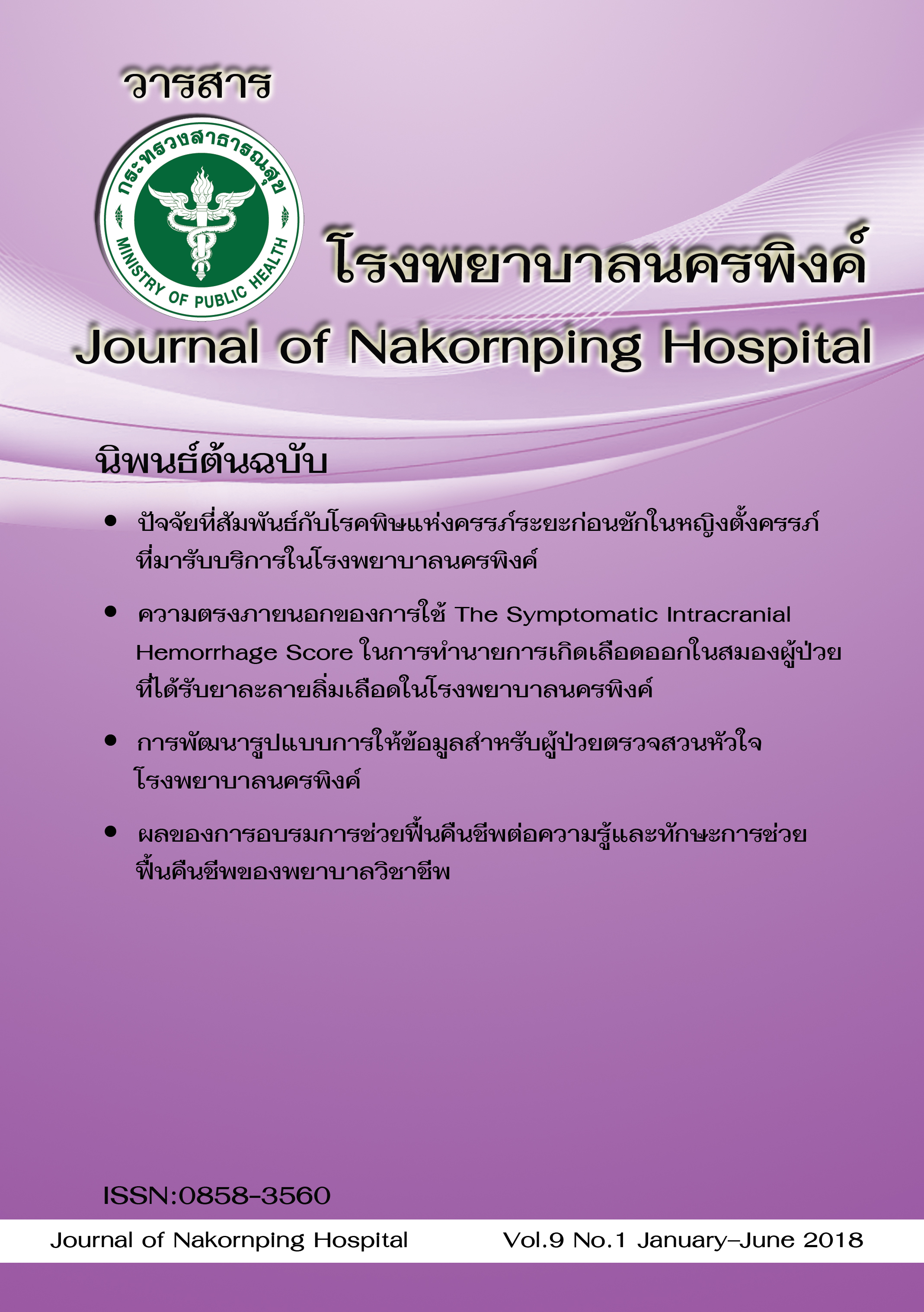ความตรงภายนอกของการใช้ The Symptomatic Intracranial Hemorrhage Score ในการทำนายการเกิดเลือดออกในสมองผู้ป่วยที่ได้รับยาละลายลิ่มเลือดใน โรงพยาบาลนครพิงค์
คำสำคัญ:
เลือดออกในสมอง ยาละลายลิ่มเลือดบทคัดย่อ
ภาวะเลือดออกในสมองหลังได้รับการรักษาด้วยยาละลายลิ่มเลือด (rt-PA) เป็นภาวะที่แทรกซ้อนที่สามารถพบได้ The Symptomatic Intracranial Hemorrhage Score (SICH score) ใช้ในการทํานายการเกิดภาวะเลือดออกในสมองที่ส่งผลให้มีอาการทางสมองแย่ลงและมีการศึกษาในประเทศไทย โดยคํานวณคะแนนจากประวัติโรคลิ้นหัวใจ การใช้ยา Aspirin ความดันโลหิตก่อนให้ยาละลายลิ่มเลือด >140 มม.ปรอท NIHSS >10 คะแนน และ >20 คะแนนระดับเกร็ดเลือด <250,000 cell/mm3 และการใช้ยาลดความ ดันโลหิตระหว่างการให้ยาละลายลิ่มเลือด งานวิจัยนี้มีจุดประสงค์เพื่อทดสอบความตรง ภายนอกของการใช้ SICH score ในการทํานายการเกิดเลือดออกในสมองของผู้ป่วยที่ ได้รับยาละลายลิ่มเลือดที่โรงพยาบาลนครพิงค์ และศึกษาปัจจัยเสี่ยงอื่นๆ ในการเกิดภาวะเลือดออกในสมอง การศึกษานี้เป็นการศึกษาแบบย้อนหลัง (Retrospective) จากผู้ป่วยที่เข้ารับการรักษาด้วยโรคหลอดเลือดสมองตีบ และมีข้อบ่งชี้ในการรักษาด้วยยาละลายลิ่มเลือด (rt-PA) ระหว่าง 1 มิถุนายน 2557 – 31 มีนาคม 2561 จํานวน 119 คน ผลการศึกษาพบว่า Asymptomatic intracranial hemorrhage 22 คน (ร้อยละ 18.5)
Symptomatic intracranial hemorrhage 12 คน (ร้อยละ 10.1) พบเป็นHemorrhagic infarction type 1 จํานวน 11 คน (ร้อยละ 9.2) Hemorrhagic infarction type 2 จํานวน 9 คน (ร้อยละ 7.6) Parenchymal hematoma type 1จํานวน 6 คน (ร้อยละ 5) Parenchymal hematoma type 2 จํานวน 7 คน (ร้อยละ5.9) และชนิดอื่นๆ 1 คน (ร้อยละ 0.8) แต่ไม่พบปัจจัยเสี่ยงอื่นๆ ที่สัมพันธ์กับการเกิดภาวะเลือดออกในสมอง ผลการใช้ SICH score พบ Sensitivity 73.5 (95% CI, 55.6-87.1) Specificity 36.9 (95% CI, 26.6-48.1) AUC-ROC 0.52 (95% CI, 0.46-0.64)Odds ratio 1.62 (95% CI, 0.68-3.86) Positive predictive value 32.1 (95% CI,21.9-43.6) และ Negative predictive value 77.5 (95% CI, 61.5-89.2) จากผลการศึกษานี้พบว่าการใช้ SICH score ไม่ได้เพิ่มความแม่นยําในการทํานายการเกิดภาวะเลือดออกในสมองที่ส่งผลให้มีอาการทางสมองแย่ลง ซึ่งอาจจะเกิดมาจากจํานวนประชากรที่เข้าร่วมงานวิจัยนี้มีปริมาณไม่มาก
References
2. Hacke W, Kaste M, Fieschi C, et al. Randomiseddouble-blind placebocontrolled trial of thrombolytic therapy with intravenous alteplase in acute ischemic stroke (ECASS II). Second European–Australasian Acute Stroke Study
Investigators. Lancet 1998;352:1245–51.
3. Hacke W, Kaste M, Bluhmki E, et al. Thrombolysis with alteplase 3 to 4.5 hours after acute ischemic stroke. N Engl J Med 2008;359:1317–29.
4. Thanin L, Sombat M, Jayanton P, et al. Prediction of Symptomatic Intracranial Hemorrhage after Intravenous Thrombolysis in Acute Ischemic Stroke: The
Symptomatic Intracranial Hemorrhage Score. Journal of Stroke and Cerebrovascular Diseases 2017:2622–2629.
5. ทัศนีย์ ตันติฤทธฺศักดิ์, แนวทางการรักษาโรคหลอดเลือดสมองตีบหรืออุดตันสําหรับแพทย์, มปส,. มปท; 2555.
6. Larrue V, von Kummer RR, Muller A, et al. Risk factors for severe hemorrhagic transformation in ischemic stroke patients treated with recombinant tissue plasminogen activator: a secondary analysis of the European-Australasian
Acute Stroke Study (ECASS II). Stroke 2001;32:438-441.
7. Lou M, Safdar A, Mehdiratta M, et al. The HAT score: a simple grading scale for predicting hemorrhage after thrombolysis. Neurology 2008;71:1417-1423.
8. Mazya M, Egido JA, Ford GA, et al. Predicting the risk of symptomatic intracerebral hemorrhage in ischemic stroke treated with intravenous alteplase: Safe Implementation of Treatments in Stroke (SITS) symptomaticintracerebral
hemorrhage risk score. Stroke 2012;43:1524-1531.
9. Cucchiara B, Tanne D, Levine SR, et al. A risk score to predict intracranial hemorrhage after recombinant tissue plasminogen activator for acute ischemic stroke. J Stroke Cerebrovasc Dis 2008;17:331-333.
10. Strbian D, Engelter S, Michel P, et al. Symptomatic intracranial hemorrhage after stroke thrombolysis: the SEDAN score. Ann Neurol 2012;71:634-641.
11. G. Menon BK, Saver JL, Prabhakaran S, et al. Risk score for intracranial hemorrhage in patients with acute ischemic stroke treated with intravenous tissue-type plasminogen activator. Stroke 2012;43:2293-2299.
12. J. H. Warwick Pexman, Philip A. Barber, Michael D. Hill, et al.Use of the Alberta Stroke Program Early CT Score (ASPECTS) for Assessing CT Scans in Patients with Acute Stroke. AJNR Am J Neuroradiol 2001: 22:1534–1542.
13. Mikhail N. Kalinin, Dina R. Khasanova and Murat M. Ibatullin. The hemorrhagic transformation index score: a prediction tool in middle cerebral artery ischemic stroke. BMC Neurology 2017:17:177.
Downloads
เผยแพร่แล้ว
How to Cite
ฉบับ
บท
License
บทความที่ได้รับการตีพิมพ์เป็นลิขสิทธิ์ของโรงพยาบาลนครพิงค์ จ.เชียงใหม่
ข้อความที่ปรากฏในบทความแต่ละเรื่องบทความในวารสารวิชาการและวิจัยเล่มนี้เป็นความคิดเห็นส่วนตัวของผู้เขียนแต่ละท่านไม่เกี่ยวข้องกับโรงพยาบาลนครพิงค์ และบุคลากรท่านอื่นๆในโรงพยาบาลฯ ความรับผิดชอบเกี่ยวกับบทความแต่ละเรื่องผู้เขียนจะรับผิดชอบของตนเองแต่ละท่าน


